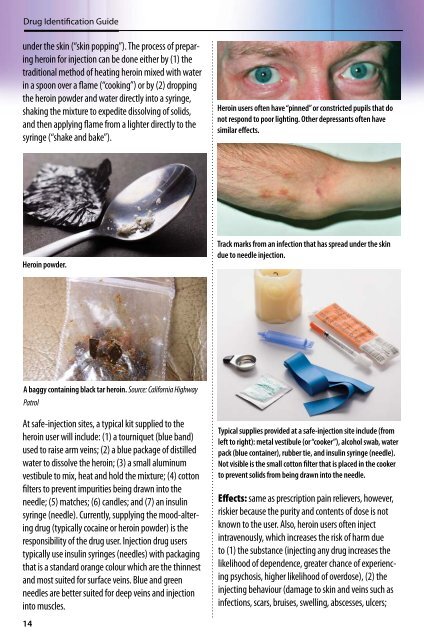Drugs Of Abuse - Sunshine Coast Health Centre
Drugs Of Abuse - Sunshine Coast Health Centre
Drugs Of Abuse - Sunshine Coast Health Centre
Create successful ePaper yourself
Turn your PDF publications into a flip-book with our unique Google optimized e-Paper software.
Drug Identifi cation Guide<br />
under the skin (“skin popping”). The process of preparing<br />
heroin for injection can be done either by (1) the<br />
traditional method of heating heroin mixed with water<br />
in a spoon over a fl ame (“cooking”) or by (2) dropping<br />
the heroin powder and water directly into a syringe,<br />
shaking the mixture to expedite dissolving of solids,<br />
and then applying fl ame from a lighter directly to the<br />
syringe (“shake and bake”).<br />
Heroin powder.<br />
A baggy containing black tar heroin. Source: California Highway<br />
Patrol<br />
At safe-injection sites, a typical kit supplied to the<br />
heroin user will include: (1) a tourniquet (blue band)<br />
used to raise arm veins; (2) a blue package of distilled<br />
water to dissolve the heroin; (3) a small aluminum<br />
vestibule to mix, heat and hold the mixture; (4) cotton<br />
fi lters to prevent impurities being drawn into the<br />
needle; (5) matches; (6) candles; and (7) an insulin<br />
syringe (needle). Currently, supplying the mood-altering<br />
drug (typically cocaine or heroin powder) is the<br />
responsibility of the drug user. Injection drug users<br />
typically use insulin syringes (needles) with packaging<br />
that is a standard orange colour which are the thinnest<br />
and most suited for surface veins. Blue and green<br />
needles are better suited for deep veins and injection<br />
into muscles.<br />
14<br />
Heroin users often have “pinned” or constricted pupils that do<br />
not respond to poor lighting. Other depressants often have<br />
similar eff ects.<br />
Track marks from an infection that has spread under the skin<br />
due to needle injection.<br />
Typical supplies provided at a safe-injection site include (from<br />
left to right): metal vestibule (or “cooker”), alcohol swab, water<br />
pack (blue container), rubber tie, and insulin syringe (needle).<br />
Not visible is the small cotton fi lter that is placed in the cooker<br />
to prevent solids from being drawn into the needle.<br />
Eff ects: same as prescription pain relievers, however,<br />
riskier because the purity and contents of dose is not<br />
known to the user. Also, heroin users often inject<br />
intravenously, which increases the risk of harm due<br />
to (1) the substance (injecting any drug increases the<br />
likelihood of dependence, greater chance of experiencing<br />
psychosis, higher likelihood of overdose), (2) the<br />
injecting behaviour (damage to skin and veins such as<br />
infections, scars, bruises, swelling, abscesses, ulcers;


